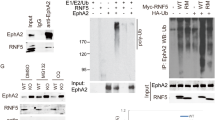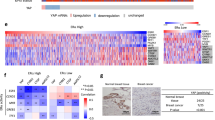Abstract
Ligands of the ErbB family of receptors and estrogens control the proliferation of breast cancer cells. Overexpression of human EGF receptor HER-2 (erbB2) leads to amplified heregulin (HRG) signaling, promoting more aggressive breast cancer that is nonresponsive to estrogen and the antiestrogenic drug tamoxifen. Herstatin (Hst), a secreted HER-2 gene product, binds to the HER-2 receptor ectodomain blocking receptor activation. The aim of this study was to investigate the impact of this HER-2 inhibitor on HRG-induced signaling, proliferation, and sensitivity to tamoxifen in breast cancer cells with and without HER-2 overexpression. The expression of Hst in MCF7 cells eliminated HRG signaling through both mitogen-activated protein kinase and Akt pathways and prevented HRG-mediated proliferation. The loss in signaling corresponded to downregulation of the HRG receptors, HER-3 and HER-4, whereas HER-2 overexpression strongly stimulated the levels of both HRG receptors. Although Hst blocked HRG signaling in both parental and HER-2 transfected cells, it enhanced sensitivity to tamoxifen only in the MCF7 cells that overexpressed HER-2. To evaluate further the efficacy of Hst as an anticancer agent, His-tagged Hst was expressed in transfected insect cells, purified, and added to the breast cancer cells. As in the transfected cells, purified Hst inhibited HER-3 levels and suppressed HRG-induced proliferation of MCF7 and BT474 breast cancer cells. In contrast, the HER-2 monoclonal antibody, herceptin, downregulated HER-2, but not HER-3. These results suggest the potential use of Hst against HRG-mediated growth of breast cancers with high and low levels of HER-2 and against tamoxifen resistance in HER-2 overexpressing breast cancer.
This is a preview of subscription content, access via your institution
Access options
Subscribe to this journal
Receive 50 print issues and online access
$259.00 per year
only $5.18 per issue
Buy this article
- Purchase on Springer Link
- Instant access to full article PDF
Prices may be subject to local taxes which are calculated during checkout






Similar content being viewed by others
Abbreviations
- RTK:
-
receptor tyrosine kinase
- EGF:
-
epidermal growth factor
- HER:
-
Human EGF receptors 1–4
- EGFR:
-
EGF receptor
- HRG:
-
heregulin
- RT–PCR:
-
reverse transcriptase–polymerase chain reaction
- MAPK:
-
mitogen-activated protein kinase
- PI3K:
-
phosphatidylinositol 3-kinase
- SDS–PAGE:
-
sodium dodecyl polyacrilamide-gel electrophoresis
References
Aguilar Z, Akita RW, Finn RS, Ramos BL, Pegram MD, Kabbinavar FF, Pietras RJ, Pisacane P, Sliwkowski MX and Slamon DJ . (1999). Oncogene, 18, 6050–6062.
Alimandi M, Romano A, Curia MC, Muraro R, Fedi P, Aaronson SA, Di Fiore PP and Kraus MH . (1995). Oncogene, 10, 1813–1821.
Arteaga CL, Chinratanalab W and Carter MB . (2001). Semin. Oncol., 28, 30–35.
Azios NG, Romero FJ, Denton MC, Doherty JK and Clinton GM . (2001). Oncogene, 20, 5199–5209.
Beerli RR, Graus-Porta D, Woods-Cook K, Chen X, Yarden Y and Hynes NE . (1995). Mol. Cell. Biol., 15, 6496–6505.
Benz CC, Scott GK, Sarup JC, Johnson RM, Tripathy D, Coronado E, Shepard HM and Osborne CK . (1993). Breast Cancer Res. Treat., 24, 85–95.
Bunone G, Briand PA, Miksicek RJ and Picard D . (1996). EMBO J., 15, 2174–2183.
Christianson TA, Doherty JK, Lin YJ, Ramsey EE, Holmes R, Keenan EJ and Clinton GM . (1998). Cancer Res., 58, 5123–5129.
Doherty JK, Bond C, Jardim A, Adelman JP and Clinton GM . (1999). Proc. Natl. Acad. Sci. USA, 96, 10869–10874.
Dowsett M . (2001). Endocr. Relat. Cancer, 8, 191–195.
Dowsett M, Harper-Wynne C, Boeddinghaus I, Salter J, Hills M, Dixon M, Ebbs S, Gui G, Sacks N and Smith I . (2001). Cancer Res., 61, 8452–8458.
Gilbertson RJ, Clifford SC, MacMeekin W, Meekin W, Wright C, Perry RH, Kelly P, Pearson AD and Lunec J . (1998). Cancer Res., 58, 3932–3941.
Graus-Porta D, Beerli RR, Daly JM and Hynes NE . (1997). EMBO J., 16, 1647–1655.
Graus-Porta D, Beerli RR and Hynes NE . (1995). Mol. Cell. Biol., 15, 1182–1191.
Guy PM, Platko JV, Cantley LC, Cerione RA and Carraway III KL . (1994). Proc. Natl. Acad. Sci. USA, 91, 8132–8136.
Heldin CH and Ostman A . (1996). Cytokine Growth Factor Rev., 7, 3–10.
Hijazi MM, Thompson EW, Tang C, Coopman P, Torri JA, Yang D, Mueller SC and Lupu R . (2000). Int. J. Oncol., 17, 629–641.
Hynes NE and Stern DF . (1994). Biochim. Biophys. Acta, 1198, 165–184.
Jeschke M, Wels W, Dengler W, Imber R, Stocklin E and Groner B . (1995). Int. J. Cancer, 60, 730–739.
Justman QA and Clinton GM . (2002). J. Biol. Chem., 277, 20618–20624.
Karunagaran D, Tzahar E, Beerli RR, Chen X, Graus-Porta D, Ratzkin BJ, Seger R, Hynes NE and Yarden Y . (1996). EMBO J., 15, 254–264.
Klapper LN, Kirschbaum MH, Sela M and Yarden Y . (2000). Adv. Cancer Res., 77, 25–79.
Kurokawa H, Lenferink AE, Simpson JF, Pisacane PI, Sliwkowski MX, Forbes JT and Arteaga CL . (2000). Cancer Res., 60, 5887–5894.
Lewis GD, Lofgren JA, McMurtrey AE, Nuijens A, Fendly BM, Bauer KD and Sliwkowski MX . (1996). Cancer Res., 56, 1457–1465.
Lopez GN, Turck CW, Schaufele F, Stallcup MR and Kushner PJ . (2001). J. Biol. Chem., 276, 22177–22182.
Mazumdar A, Adam L, Boyd D and Kumar R . (2001). Cancer Res., 61, 400–405.
Nicholson BP . (2000). Semin. Oncol., 27, 33–37.
Pegram M and Slamon D . (2000). Semin. Oncol., 27, 33–37.
Pietras RJ, Arboleda J, Reese DM, Wongvipat N, Pegram MD, Ramos L, Gorman CM, Parker MG, Sliwkowski MX and Slamon DJ . (1995). Oncogene, 10, 2435–2446.
Pinkas-Kramarski R, Shelly M, Glathe S, Ratzkin BJ and Yarden Y . (1996). J. Biol. Chem., 271, 19029–19032.
Pinkas-Kramarski R, Shelly M, Guarino BC, Wang LM, Lyass L, Alroy I, Alimandi M, Kuo A, Moyer JD, Lavi S, Eisenstein M, Ratzkin BJ, Seger R, Bacus SS, Pierce JH, Andrews GC, Yarden Y and Alamandi M . (1998). Mol. Cell. Biol., 18, 6090–6101.
Plowman GD, Green JM, Culouscou JM, Carlton GW, Rothwell VM and Buckley S . (1993). Nature, 366, 473–475.
Ram TG, Hosick HL and Ethier SP . (2000). J. Cell Physiol., 183, 301–313.
Read LD, Keith Jr D, Slamon DJ and Katzenellenbogen BS . (1990). Cancer Res., 50, 3947–3951.
Riese II DJ and Stern DF . (1998). Bioessays, 20, 41–48.
Sartor CI, Zhou H, Kozlowska E, Guttridge K, Kawata E, Caskey L, Harrelson J, Hynes N, Ethier S, Calvo B and Earp III HS . (2001). Mol. Cell. Biol., 21, 4265–4275.
Schlessinger J, Ullrich A, Honegger AM and Moolenaar WH . (1988). Cold Spring Harb. Symp. Quant. Biol., 53, 515–519.
Siegel PM, Ryan ED, Cardiff RD and Muller WJ . (1999). EMBO J., 18, 2149–2164.
Slamon DJ, Godolphin W, Jones LA, Holt JA, Wong SG, Keith DE, Levin WJ, Stuart SG, Udove J, Ullrich A and Press MF . (1989). Science, 244, 707–712.
Sliwkowski MX, Schaefer G, Akita RW, Lofgren JA, Fitzpatrick VD, Nuijens A, Fendly BM, Cerione RA, Vandlen RL and Carraway III KL . (1994). J. Biol. Chem., 269, 14661–14665.
Sweeney C, Fambrough D, Huard C, Diamonti AJ, Lander ES, Cantley LC and Carraway III KL . (2001). J. Biol. Chem., 276, 22685–22698.
Tan M, Grijalva R and Yu D . (1999). Cancer Res., 59, 1620–1625.
Tang CK, Perez C, Grunt T, Waibel C, Cho C and Lupu R . (1996). Cancer Res., 56, 3350–3358.
Tzahar E, Levkowitz G, Karunagaran D, Yi L, Peles E, Lavi S, Chang D, Liu N, Yayon A and Wen D . (1994). J. Biol. Chem., 269, 25226–25233.
Tzahar E, Waterman H, Chen X, Levkowitz G, Karunagaran D, Lavi S, Ratzkin BJ and Yarden Y . (1996). Mol. Cell. Biol., 16, 5276–5287.
van der Geer P, Hunter T and Lindberg RA . (1994). Annu. Rev. Cell Biol., 10, 251–337.
Wallasch C, Weiss FU, Niederfellner G, Jallal B, Issing W and Ullrich A . (1995). EMBO J., 14, 4267–4275.
Xiong S, Grijalva R, Zhang L, Nguyen NT, Pisters PW, Pollock RE and Yu D . (2001). Cancer Res., 61, 1727–1732.
Acknowledgements
We thank Jennifer Rhodes for Herstatin purification and Tina Purnat for excellent administrative assistance. This study was supported by an NIH grant from the National Cancer Institute to GMC.
Author information
Authors and Affiliations
Corresponding author
Rights and permissions
About this article
Cite this article
Jhabvala-Romero, F., Evans, A., Guo, S. et al. Herstatin inhibits heregulin-mediated breast cancer cell growth and overcomes tamoxifen resistance in breast cancer cells that overexpress HER-2. Oncogene 22, 8178–8186 (2003). https://doi.org/10.1038/sj.onc.1206912
Received:
Revised:
Accepted:
Published:
Issue Date:
DOI: https://doi.org/10.1038/sj.onc.1206912
Keywords
This article is cited by
-
Targeting ErbB2 and ErbB3 with a bispecific single-chain Fv enhances targeting selectivity and induces a therapeutic effect in vitro
British Journal of Cancer (2008)
-
Phosphorylation of the ErbB3 binding protein Ebp1 by p21-activated kinase 1 in breast cancer cells
British Journal of Cancer (2008)
-
Protein 4.1B expression is induced in mammary epithelial cells during pregnancy and regulates their proliferation
Oncogene (2005)
-
Resistance to endocrine therapy in breast cancer
Cancer Chemotherapy and Pharmacology (2005)
-
HES-1 inhibits 17β-estradiol and heregulin-β1-mediated upregulation of E2F-1
Oncogene (2004)



